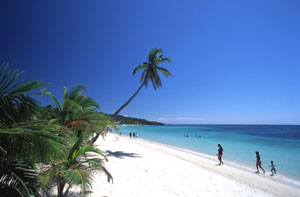|
From 1650 and almost 100 years later, the Pirates of the Caribbean had a safe base in the Bay Islands in the Gulf of Honduras.
In 1502, in his fourth and last voyage, Christopher Columbus arrived to Guanaja, the farthest island from mainland, and called it Island of the Pine Trees, because of the great amount of conifers that fill up its hills. The strategic position of the islands in the American Gold Spanish Route turned them into pirates' target. Thus, Dutchmen and Frenchmen began to gain ground to the Spaniards until the British finally cleared the Spaniards out of the island.
After the pirates left and already under the British Control, the islands received all kinds of immigrants. First, in 1797 the Garifun Population arrived, unredeemed black people from San Vicente; next, successive surges of white settlers and freed slaves. In 1821, with its independence, Honduras claimed its rights over the islands; same that were consolidated in 1859 with the "Wyke-Cruz Treaty" between the Central American nation and Great Britain. Then Spanish speaking settlers began to arrive.
The outcome, a bilingual culture with a Creole English and an archaism-scattered Spanish; and beyond all difference, a cheerful, unconcerned, and kind nature. Obviously, fishing is the Islands main activity, but in the 80's, the Scuba Divers discovered the wonders of the area. Nowadays, tourism stands out as the most growing activity in the archipelago, combining scuba diving, snorkeling, sport fishing, sailing, and all kinds of activities that benefit from the gifts provided by nature, including the simple rest in celestial beaches.
In general, everything in the Bay Islands is awesome, but scuba diving is literally an experience from another world, the world under the sea. Tropical and multicolored fish, delicate starfish, crabs, turtles, rays, gigantic coral tapestry, sponges, seaweeds, crustaceans, a whole submarine universe parading in a charming spectacle with the intensity that only Mother Nature itself can give. The Bay Islands in Honduras, an example of the best of the latin spirit. |
|
|
